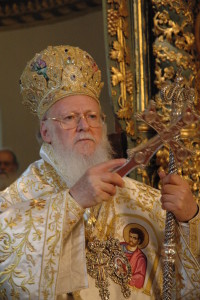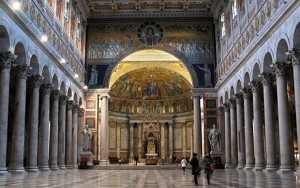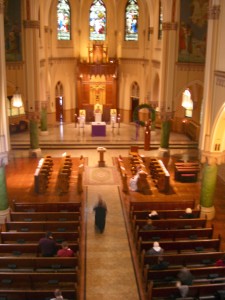For the first three installments of this series, see here, here, and here.
Our community organized a pilgrimage for the Holy Year of 2000. We began in Istanbul, where we visited the ancient churches of the great Eastern see and had a private audience with Patriarch Bartholomew. From there we journeyed to Rome where we attended Mass on the 80th birthday of Pope John Paul II, a sweltering day in late May. The Holy Father somehow got stronger as the day heated up, in spite of his advanced Parkinson’s at the time.

His All-Holiness Ecumenical Patriarch Bartholomew. As a young man, he studied in Rome with the Benedictines! So he surprised the Greek pilgrims with us that day with an eloquent teaching on St. Benedict. Pray for his persecuted church!
On the other days in Rome, we celebrated Mass at the other papal basilicas. The three priests of our community took turns being the principal celebrant. On the last day, we were scheduled to offer Mass at a side chapel at Saint Paul’s Outside the Walls. This was personally significant. During the planning stages of the pilgrimage, it was uncertain whether we would attract enough interest to be able to afford to go. So I prayed fervently to Saint Paul to ask his help in attaching more pilgrims to our trip. When we finally arrived in Rome, I looked forward to visiting his tomb and saying, “Thank you.”

St. Paul’s Outside the Walls, built over the grave of The Apostle. Carbon 14 and DNA tests carried out eight years ago on remains from a sarcophagus in the crypt convinced Pope Benedict XVI that they really were Paul’s.
The day before we were to visit St. Paul’s, the priest who had been scheduled to offer Mass there came down with a toothache. It got so bad the next morning that he was rushed to a dentist and had a root canal performed. He would not make it back for Mass. So the priest who was leading the tour decided to step in and offer Mass in his place.
As I mentioned yesterday, we were at that time in the midst of a passionate discussion about experimenting with Mass ad orientem. Two of the three priests wanted to try it and one was opposed–the opposing priest happened to be the one leading the pilgrimage. So it was with delightful irony that we strode together into Saint Paul’s and headed for the side chapel that had been assigned to us, only to discover that the altar there was fixed to the eastern wall. As this dawned on our trusty guide, he stopped in his tracks, turned to me and the other priest, rolled his eyes and grinned. Of all of us, he would be the first priest to celebrate Mass ad orientem.
He took the hint and agreed to go along with an experimental use of Mass facing East. When we returned to Chicago, we began to face East twice a week, on Mondays and Saturdays just to try it out. It felt awkward at first. There were questions about when to turn, which way to turn, and so on. However, this brought out more clearly certain indicative phrases within the rubrics of the current Roman Rite. At a few places in the Missal, the rubrics included the Latin phrase, “sacerdos conversus ad populum” which literally means, “the priest, having turned towards the people.” The implication is that his typical stance is not towards the people. I may at some point weigh in on the various controversies that beset the translation of this phrase and others (such as paragraph 299 from the General Instruction on the Roman Missal, where there is a dispute about the normativity of Mass facing the people, based on a potentially ambiguous Latin pronoun, a problem aggravated the low level of Latin knowledge in the clergy at large), but let me continue with anecdotes.
It is important to note that we wanted, if possible, to steer clear of polarizing “left” or “right” issues. As monks in the cloister, we didn’t feel that these were battles in which we needed or even ought to take sides. We saw value in either orientation at Mass, which is why we used both. Neither affects the validity of the sacrament, and Christ is present in either case.
After a couple of years, we sensed a growing desire to use the Easter orientation more regularly. Why? In those days I said that our community life was so intense that the last thing we needed was to look at each more. I was half joking, but this captured some of our experience. When the presider turned around, we all faced the same direction. The symbolism intended is that we all together face toward the place of Christ’s expected return. The principal celebrant becomes one with everyone else, rather than someone separated out and facing a different direction.
We also were slowly discovering certain given features of our church’s architecture. In the year that the parish had been closed, before the brothers arrived from Paris to begin monastic life in Chicago, the building had been stripped almost entirely of furnishings. Where the tabernacle had been, in the center of the sanctuary stood the old predella, now badly damaged. So at first we kept the tabernacle on the side of the church. We did this until we noticed that people would walk right by it and fail to notice it was there. So we shored up the predella and moved the tabernacle back to the center of the sanctuary.

The architecture of our basilica-style church invites those entering to journey toward God, along a strong ‘vertical’ axis running the length of the church and (now) culminating at the altar.
This brought about an almost tactile sense of the connection of the altar of sacrifice and the reserved Sacrament in the tabernacle. And it was especially apparent when celebrating Mass ad orientem, since the priest was no longer standing between the altar and the tabernacle. All of this gradually led us to a greater appreciation of the strong vertical thrust of our neo-gothic church. And this verticality connected to our desire to encounter and communicate God’s transcendence.
Now, it needs to be said that God is also immanent, and this is especially important to grasp in the exercise of the common priesthood of the faithful gathered at the liturgy. Our attempts to realize this aspect of the liturgy will appear in a few installments as we get closer to the construction of our new choir. First, however, it will benefit us to keep working away at the transcendent and eschatological dimensions of the liturgy. Next: the commissioning of the iconostasis that you can see on our home page.